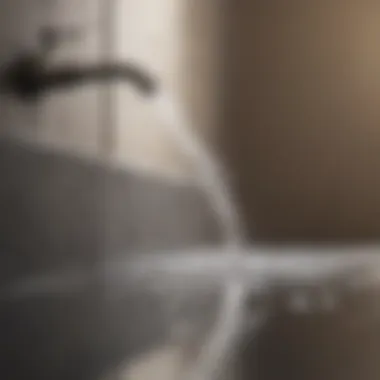Effective Home Remedies to Unclog Your Drain


Intro
Clogged drains are a common household nuisance. They can lead to unpleasant odors, slow water drainage, and even more severe plumbing issues if not addressed in time. Understanding how to unclog a drain using home remedies can save homeowners from costly plumbing fees and the potential harm of harsh chemical cleaners. This guide will delve into effective home remedies, focusing on simple methods that utilize items commonly found in most kitchens and bathrooms.
Many drains become obstructed due to a buildup of grease, hair, soap scum, or food particles. Rather than turning to commercial products, many of which can be harmful to the environment, it is practical to explore eco-friendly solutions. By employing easy methods and employing items like baking soda and vinegar, homeowners can tackle drainage issues successfully.
This article will provide a comprehensive overview of various remedies, highlighting their effectiveness, ease of use, and safety. Readers will gain insight into the causes of clogs, practical solutions, and tips for preventing future issues. With a well-informed approach, anyone can navigate the headache of clogged drains.
Understanding Drain Clogs
Understanding drain clogs is crucial for homeowners and anyone dealing with plumbing issues. The knowledge of why clogs occur aids in prevention and appropriate responses to blockages. This section sheds light on the common causes of drain clogs. It also highlights how to identify these clogs early. Being informed allows individuals to use home remedies effectively before reaching for chemical solutions.
Common Causes of Drain Clogs
Accumulation of hair
Accumulation of hair is one of the most common reasons for clogged drains. Hair collects in various parts of the plumbing system and can create significant blockages over time. A key characteristic of hair clogs is their gradual formation, which means homeowners may not notice the issue until the drain flow is severely impaired. This is a beneficial focus for our article, as understanding this type of clog encourages users to adopt preventive measures. Regularly removing hair from bathroom drains can reduce the likelihood of severe clogs.
Grease and soap buildup
Grease and soap buildup frequently occurs in kitchen sinks. Grease from cooking and soap residue can harden and create blockages within pipes. This type of clog is often difficult to detect until it has formed a significant obstruction. Its key characteristic is the sticky nature of grease, which allows it to adhere to pipe walls. This feature highlights the importance of understanding how everyday activities contribute to drain problems. A major advantage of addressing grease issues early is minimizing potential costly plumbing repairs later on.
Food particles
Food particles are common contributors to drainage issues, especially in sinks used for washing dishes. Small bits of food can accumulate within pipes, leading to slow drainage. The unique characteristic of these clogs is that they often result from improper disposal practices. Recognizing this aspect is vital as it emphasizes the need for mindful food disposal. Regular cleaning and the use of strainers can prevent food particles from creating blockages, making it a useful focus for maintaining functional drains.
Foreign objects
Foreign objects, such as toys, sanitary products, or excessive toilet paper, can lead to significant clogs in drains. These objects often do not dissolve or break down, creating an immediate blockage that restricts water flow. The key feature of foreign objects is their irregular size and shape, which makes them problematic in the plumbing system. Educating homeowners about this cause is beneficial, as it encourages a cautious approach regarding what is allowed to enter drains and toilets. Being mindful can save a great deal of frustration and expense.
Signs of a Clogged Drain
Slow drainage
Slow drainage is often the first sign of a clogged drain. When water flows slowly, it indicates partial blockage. This sign is essential for the overall understanding of clogs as it allows timely intervention. Homeowners can address minor slow drainage issues before they escalate into severe problems that may require professional help.
Unpleasant odors
Unpleasant odors can emerge from a clogged drain due to material breakdown. Such smells are often indicative of stagnation and decay. This warning sign emphasizes the importance of prompt attention. The presence of foul odors can alert homeowners before conditions worsen, guiding them to take suitable action.
Gurgling sounds


Gurgling sounds from drains signal air trapped in the plumbing system. These sounds often indicate a blockage is forming or has already occurred. Gurgling can be an effective early warning system. Recognizing this noise can prompt quick preventative measures, helping to mitigate further complications.
Water puddles
Water puddles around drain areas can signal significant issues. They indicate that draining is not occurring as it should, possibly due to a clog. This observation is particularly crucial in outdoor or basement areas where puddles can lead to more serious water damage. Homeowners need to take immediate steps upon noticing such signs to minimize potential damage.
Preventative Measures
It is crucial to understand that preventing drain clogs is far simpler than dealing with the fallout of an existing blockage. Employing preventative measures not only saves time and frustration but also often reduces the need for costly plumbing services. This section explores essential practices that can help in maintaining a clear drainage system.
Regular Maintenance Practices
Using drain covers
Using drain covers is one effective way to prevent debris from entering your pipes. These simple devices act as a barrier, stopping hair, food particles, and other materials from causing clogs. The key characteristic of drain covers is their ability to be easily cleaned and replaced. Many homeowners find them a popular choice because they require minimal effort to maintain. However, it is important to regularly check and clean these covers to ensure they function effectively. Neglecting them may lead to overflow or backup, which is undesirable.
Periodic cleaning
Periodic cleaning of drains plays a vital role in preventing clogs. This entails using natural solutions like baking soda and vinegar or even just warm water. The unique feature of this practice is that it not only helps in breaking down grime but also maintains the integrity of the pipes. Regular cleaning is beneficial because it can significantly delay the onset of noticeable clogs. However, the drawback is that it requires consistency and commitment from homeowners to be effective.
Monitoring water flow
Monitoring water flow is essential for spotting potential issues before they become serious. This means paying attention to any changes in how quickly water drains from sinks, showers, or tubs. A noticeable slowdown can indicate a developing clog. The unique feature of this measure is its proactive nature, allowing homeowners to address problems early. It is a beneficial practice because it fosters greater awareness of the plumbing system. Nevertheless, it can be overlooked in busy households, making vigilance important.
Avoiding Common Pitfalls
Avoiding common pitfalls is equally important in maintaining a healthy drainage system. Making small adjustments in behavior can have a significant impact on preventing clogs in the long run.
Disposing of grease properly
Disposing of grease properly is critical since pouring it down the sink leads to buildup over time. The key characteristic of this practice is understanding that grease solidifies in pipes, narrowing them and causing blockages. This is a beneficial choice because it helps keep drains clear. The unique feature of proper grease disposal can be as simple as using a jar to collect it for later disposal. Ignoring this advice can result in significant plumbing issues, so it is essential to be vigilant.
Limit food waste in sinks
Limiting food waste in sinks prevents debris from contributing to clogs. This practice involves being aware of what is being washed down after a meal. The key characteristic is the ability to reduce food-related remnants entering the drains. It is beneficial because it lessens the strain on your plumbing system and can lead to less frequent clogging. However, this requires a change in habits, which may take time to establish.
Being mindful of what goes down the drain
Being mindful of what goes down the drain cannot be overstated. This entails being selective about what materials are rinsed, such as avoiding non-biodegradable items and excessively large food scraps. The uniqueness of this approach lies in its simplicity and effectiveness. It is beneficial because mindfulness reduces the risk of severe blockages. However, it may require family discussions at home to ensure collective responsibility.
Effective preventative measures are fundamental in maintaining clear and functional drains. Regular practices and mindful decisions can greatly reduce the frequency of clogs.


Home Remedies for Unclogging Drains
Unclogging drains can be a common but often frustrating household chore. Home remedies present a practical alternative to chemical cleaners, which may pose health or environmental risks. This article explores various effective methods using readily available household items. These remedies are generally cost-effective and less harmful, making them a viable first line of defense against clogs. By understanding and applying these approaches, you can maintain plumbing systems with confidence and reduce dependency on expensive and harsh commercial products.
Boiling Water
One of the simplest yet effective remedies for unclogging a drain is boiling water. The heat from the boiling water can help dissolve accumulated grease and soap that coats the inside of pipes. To use this method, boil a kettle filled with water and carefully pour it down the affected drain in stages. This process should ideally be repeated several times. It’s easy to implement and does not require special tools or equipment.
Baking Soda and Vinegar
This combination is perhaps one of the most popular home remedies for unclogging drains. Baking soda, an alkaline substance, combined with vinegar, which is acidic, creates a chemical reaction that can help to dislodge stubborn clogs. To use this remedy, pour half a cup of baking soda down the drain, followed by an equal amount of vinegar. Cover the drain with a cloth or a stopper to keep the reaction concentrated inside the pipe. Allow it to sit for about twenty to thirty minutes before flushing with boiling water. This method is effective against various types of clogs and is safe for most plumbing systems.
Salt and Baking Soda Mixture
Using salt and baking soda is another effective method to tackle drain clogs. When mixed together, they can create a powerful solution for cleaning. You can use half a cup of each. First, pour the salt and baking soda mixture down the drain, followed by hot water. Let it sit for a few hours, or overnight if possible, then rinse with boiling water. This method is non-toxic and can help efficiently break down food particles and other residues.
Dish Soap and Hot Water
Dish soap is not only effective in cleaning dishes but can also aid in loosening blockages. It works especially well when grease is clogging the drain. To use this remedy, pour a good amount of dish soap down the drain followed by a kettle of hot water. The dish soap will help to lubricate the clog and break down grease, allowing water to flow through more freely.
Plunger Use
Correct technique
To use a plunger effectively, start by ensuring there is enough water in the sink or tub to cover the rubber part of the plunger. Position the plunger over the drain, creating a tight seal. Once set, use firm and swift thrusts to create suction. This action can help dislodge objects causing the blockage. The simplicity of this technique makes it a common and practical choice for homeowners facing drain issues.
Types of plungers
There are different types of plungers designed for various tasks. The most common types are the cup plunger and the flange plunger. The cup plunger is excellent for flat surfaces like sinks, while the flange plunger is designed for toilets, having an extended rubber lip that fits into the toilet bowl. Choosing the right plunger type is crucial as it can greatly enhance effectiveness when unclogging.
Wet/Dry Vacuum
A wet/dry vacuum can also be a useful tool for unclogging drains. If you find that the blockage is significant, using this type of vacuum can be effective in sucking out the debris. First, remove as much water as possible from the area surrounding the drain. Then, set the vacuum to liquid mode and place the hose over the drain. This method is powerful and can often clear stubborn clogs that other methods might not tackle.
When to Seek Professional Help
Understanding when to call in a professional can save time and prevent further damage to plumbing systems. Homeowners might try multiple home remedies to address simple clogs. However, some situations merit professional intervention. Knowing the signs can help avoid complications.
Identifying Persistent Issues
Frequent clogs


Frequent clogs indicate a recurring problem rather than a one-time issue. This could mean the drainage system is suffering from underlying problems that home remedies cannot resolve. If sinks or drains clog multiple times in a short span, it is often a signal of larger blockages or damage within the system. Persistent clogs require a thorough inspection.
The key characteristic of frequent clogs is their repetitive nature. Homeowners may initially think minor attempts to remove them are enough. However, ignoring such a sign could lead to larger headaches or even flooding. A plumber’s expertise often reveals hidden issues or more complex blockages, ensuring that remedies genuinely address the cause, not just the symptom.
Multiple drains affected
When multiple drains in a home show signs of clogging, it suggests systemic issues. This sign often points to a blockage further down the line, possibly in the main sewer line. Neglecting to address this promptly can lead to backflow issues or other severe plumbing problems.
The key characteristic of multiple drains being affected is the simultaneous appearance of signs of clogs. This is usually more alarming than a single drain situation. This indication is crucial for deciding whether to call professionals, as they can apply specialized techniques to locate and resolve the underlying cause more accurately.
Potential Underlying Problems
Tree root intrusion
Tree root intrusion occurs when roots penetrate the drainage pipes, often resulting in severe blockages. Trees naturally seek out moisture, which can lead them to invade pipes looking for a water source. This can cause significant damage to the plumbing over time and requires professional assessment and intervention.
The unique feature of tree root intrusion is its gradual buildup. Homeowners might go undiagnosed for years as this problem worsens without active measures taken. Professional help becomes essential as they can utilize specialized equipment to assess the extent of the root damage and provide effective solutions.
Pipe damage
Pipe damage can emerge from various sources, such as aging pipes, temperature changes, or external pressure. Cracks or dislocated segments can lead to clogs and backups. If a clog persists despite remedies, there may be unseen damage requiring specialized tools to resolve.
The distinctive characteristic of pipe damage is that it isn't just about blocked water flow. This could signal leaking pipes or even structural concerns for homes. Hence, recognizing signs of damage early is vital. This situation calls for professional assessment to prevent broader problems such as mold or more significant leaks.
Severe blockages
Severe blockages are typically the result of the buildup of foreign objects, hair, and grease. They tend to resist standard home remedies and can cause overflow, posing risks of property damage or unhealthy conditions. When a blockage is so severe that no remedy seems to work, the expertise of a trained professional is necessary.
The nature of severe blockages is their insistence and resistance to treatment. They can indicate more extensive issues within a plumbing system. Seeking professional help ensures that the extent of the blockage is accurately identified and remedied properly. Plumbers have access to advanced tools that can effectively tackle severe issues, providing long-term solutions.
Finale
In discussing home remedies to unclog drains, it is crucial to understand the relevance and practical benefits of these techniques. This article serves as a comprehensive guide for homeowners who seek natural solutions to a common plumbing issue. The focus on home remedies not only highlights the ease of access to effective solutions but also fosters an eco-friendly mindset.
Using household items, the remedies presented here reduce reliance on harsh chemicals, which can harm both health and the environment. The exploration of methods—such as using vinegar and baking soda or employing a plunger—offers readers a variety of tactics they can apply with confidence.
Summary of Home Remedies
The key home remedies discussed throughout this article include:
- Boiling Water: A straightforward and often effective method for clearing minor clogs caused by grease or soap buildup.
- Baking Soda and Vinegar: This combination reacts vigorously, helping to break down organic matter in pipes.
- Salt and Baking Soda Mixture: When mixed with hot water, this creates a powerful cleaner that can dislodge clogs.
- Dish Soap and Hot Water: A practical approach to breaking up grease that often accumulates in kitchen sinks.
- Plunger Use: Mastering the technique with the right plunger type can yield significant results.
- Wet/Dry Vacuum: A less conventional but effective tool for pulling out stubborn blockages.
These remedies emphasize the importance of timely intervention against drain issues, often mitigating more severe plumbing problems.
Final Thoughts on Drain Maintenance
Drain maintenance requires a proactive stance. Regular practices such as monitoring usage and maintaining cleanliness can greatly diminish the risk of clogs. Being aware of common pitfalls, such as improper disposal habits, is essential for long-term plumbing health.







